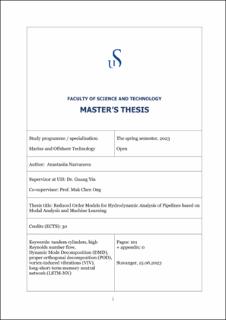Reduced Order Models for Hydrodynamic Analysis of Pipelines based on Modal Analysis and Machine Learning
Master thesis
Permanent lenke
https://hdl.handle.net/11250/3089861Utgivelsesdato
2023Metadata
Vis full innførselSamlinger
Sammendrag
Bluff bodies have extensive implementation in engineering. For instance, marine risers, jumpers, umbilicals, and bundle flowlines are the examples of thecircular bluff bodies which are used in the field of offshore engineering. They can be designed both to be fixed or flexible supported and to be a single or tandem configurations. The subsea structures are subjected to the external hydrodynamic loads such as cyclic loads, vibrations, high pressure, etc. For example, one of the commonly observed damaging flow features associated with hydrodynamics of the flexible supported bluff bodies is vortex shedding. Therefore, investigation of the instantaneous flow structures and the hydrodynamic forces acting on the bluff bodies at the operational conditions need to be performed to prevent the degradation mechanisms and increase service life of the subsea structures. Nowadays, the modern techniques are used in order to analyse the flow field data with high efficiency. For example, neural networks (NNs) are trained with massive experimental or numerical simulation data to predict the spatial-temporal evolution of the dominant coherent structures of the flow field and structural behaviour can be considered as an alternative to the conventional computational fluid dynamics (CFD) simulations. In the present thesis, numerical investigations of the flow around cylindrical bluff bodies in the upper transition Reynolds number regime (𝑅𝑒 = 3.6 ∙ 10^6 ) are performed. Two pipelineoperational conditions are considered. First one is tandem configuration of the two stationary pipelines subjected to steady flow. Second one is a pipeline undergoing the vortex-induced-vibrations (VIV) subjected to a steady current. Two-dimensional (2D) Unsteady Reynolds-Averaged-Navier-Stokes (URANS) equations combined with the standard k−w SST turbulence model are solved. The open source CFD toolbox OpenFOAM v2012 is employed to perform the simulations. The Reduced Order Models (ROMs) which can provide a low-dimensional representation of the simulation data with reduced computational time and cost are designed. Dynamic mode decomposition (DMD) and proper orthogonal decomposition (POD) techniques areimplemented for the first and second cases, respectively. In addition, further development of the ROMs for the VIV cylinder case is done by implementing the long short-term neural network (LSTM-NN). The neural network based model allows to make the predictions of the dominant hydrodynamic characteristics of the flow around the cylindrical bluff bodies subjected to a high Reynolds number flow at a future time instances with a reduced computational cost.
